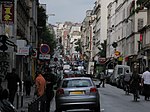Musée Édith Piaf
AC with 0 elementsBiographical museums in FranceBuildings and structures in the 11th arrondissement of ParisFrench museum stubsMuseums in Paris ... and 2 more
Music museums in FranceÉdith Piaf

The Musée Édith Piaf is a private museum dedicated to singer Édith Piaf located in the 11th arrondissement at 5, rue Crespin du Gast, Paris, France. It is open by appointment; admission is free.The museum was created by Bernard Marchois, author of two Piaf biographies, and occupies two rooms within a private apartment. It contains memorabilia including her china collection, gold and platinum records, dress and shoes, photographs, fan letters, sheet music, posters, and recordings.
Excerpt from the Wikipedia article Musée Édith Piaf (License: CC BY-SA 3.0, Authors, Images).Musée Édith Piaf
Rue Crespin du Gast, Paris 11th Arrondissement (Paris)
Geographical coordinates (GPS) Address Nearby Places Show on map
Geographical coordinates (GPS)
| Latitude | Longitude |
|---|---|
| N 48.86617 ° | E 2.38172 ° |
Address
Rue Crespin du Gast 5;7
75011 Paris, 11th Arrondissement (Paris)
Ile-de-France, France
Open on Google Maps











